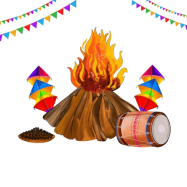Lohri
Lohri is the festival celebrated every year on 13th January. It is believed that the festival is celebrated on the day when days start becoming shorter and the nights start becoming longer. This festival is celebrated as the harvest festival. Read more in detail.
About Lohri
- The festival Lohri is celebrated every year on 13th January.
- This festival is Popular winter folk festival celebrated primarily in Northern India.
- It is observed or celebrated in the night before Makar Sankranti. The date of Lohri changes every 70 years.
- The official holiday is given in Punjab, Himachal Pradesh and Jammu & Kashmir. It is celebrated in other states also such as Haryana, Delhi and more but is not gazetted or official holiday.
- Festival is celebrated by all religions such as Sikhs, Hindus and others.
- Usually comes in the month of Paush or Magh.
- The people of Sindhi community observe this festival as “Lal Loi”.
- It is celebrated to denote the last of the coldest days of winter.
It is associated with the worship of the sun and fire and is observed by all communities with different names, as Lohri is an exclusively Punjabi festival.
History
European visitors, including Wade in 1832 and Captain Mackeson in 1836, documented the observance of Lohri at the Lahore durbar of Maharaja Ranjit Singh, noting the distribution of rewards and the tradition of lighting a significant bonfire, with references to the continued celebration in the royal court as late as 1844.
The Lohri celebration, rooted in the folklore of ancient Himalayan communities, signifies the joyous commemoration of the increasing daylight following the winter solstice, traditionally observed through communal bonfires by Hindus and Sikhs to mark the transition toward longer days after the Rabi season. It celebrates the days getting longer as the sun proceeds on its northward journey. The day after Lohri is celebrated as Makar Sankranti.[1]
Lohri is considered to have been derived from the word “Loi”, who was the wife of kabir, the great saint. While some people believe that it originated from the word “Loh” which is a device used for making chapattis. In some parts of the state people also believe that the festival’s name originated from the name of the sister of Holika, who survived the fire while Holika herself died. Besides that, some people also believe that that the word Lohri originated from the word tilorhi which comes from the combination of the words rorhi and til.[2]
The origin of Lohri is related to the central character of most Lohri songs is Dulla Bhatti, a Muslim highway robber who lived in Punjab during the reign of Emperor Akbar. Besides robbing the rich, he rescued Hindu girls being forcibly taken to be sold in slave market of the Middle East. He arranged their marriages to Hindu boys with Hindu rituals and provided them with dowries. Understandably, though a bandit, he became a hero of all Punjabis. So every other Lohri song has words to express gratitude to Dulla Bhatti.[3]
Historically, during the 19th century, revenue for winter crops was collected either on Lohri or Maghi.
Celebrations
It is believed that the festival is celebrated on the day when days start becoming shorter and the nights start becoming longer. This festival is celebrated as the harvest festival. On this day people light bonfire, sing songs and dance in joy to pay respect to the Dulha Batti.
People wear colorful and bright clothes and all come together and enjoy dancing in Gidda and Bhangra. Punjabi songs are sung, and everybody rejoices. Sarson da saag with makki di roti is usually served as the main course at a Lohri dinner.
In Jammu, on the occasion of Lohri festival, Chhaja dance was very popular. The dancers dance around a replica of peacock on the tune of drums and other musical instruments. During Lohri, Hirna dance is performed when the dancers dance on the tune of Hirana song. They disguise themselves in the garb of a deer and visit the houses of the people where some auspicious ceremony has been ceremonized. They get eatables in addition to some money from the housewives. They carry this Chajja and go from one house to other house celebrating Lohri.
In various places, about 10 to 15 days before Lohri, Groups of young and teenage boys and girls go around their neighbourhood collecting logs for the Lohri bonfire and some collects money as in name of sweets.
In the evening, people gather around the rising flames, circle around (parikrama) the bonfire and throw puffed rice, popcorn and other munchies into the fire, shouting "Aadar aye dilather jaye" (May honor come and poverty vanish!), and sing popular folk songs. This is a sort of prayer to Agni, the fire god, to bless the land with abundance and prosperity.
After the parikrama, people meet friends and relatives, exchange greetings and gifts, and distribute prasad (offerings made to god). The prasad comprises five main items: til, gajak, jaggery, peanuts, and popcorn. Winter savories are served around the bonfire with the traditional dinner of makki-ki-roti (multi-millet hand-rolled bread) and sarson-ka-saag (cooked mustard herbs).
Significance of Festival
- Harvest Festival: Lohri is primarily a celebration of the harvest of rabi crops, particularly sugarcane. Farmers celebrate the bountiful harvest by lighting bonfires, which symbolize the warmth and the energy of the sun. It is a way to express gratitude for the crops and pray for a prosperous year ahead.
- Winter to Spring Transition: Lohri marks the end of the winter season and the beginning of the longer, warmer days of spring. The festival signifies the triumph of light over darkness, warmth over cold, and new beginnings.
- Cultural Significance: The festival is celebrated with music, dance (especially Bhangra and Gidda), and traditional foods like til (sesame seeds), jaggery, and popcorn. People gather around bonfires, singing folk songs and offering offerings such as sesame seeds, sugarcane, and rewaries (a type of sweet).
- Religious Significance: Lohri is also associated with the worship of the fire and the Sun God. It is believed that the bonfire helps to purify the atmosphere and brings blessings for the new season.
- Symbol of New Beginnings: The festival is also associated with the hope of new beginnings and prosperity. It is often celebrated by families, especially newlyweds or families with newborns, as a way to usher in good fortune.
In olden times, human beings lit fires to keep away flesh-eating animals and protect their habitations. Everyone contributed to this communal fire, for which young boys and girls collected firewood from the jungle. That is why even today when people burn cow-dung cakes it is teenagers who go around collecting them. The Lohri bonfire is symbolic of our old method of protecting ourselves as well as a form of fire worship. It is to the Lohri fire that couples pray for more children and parents for husbands for their unmarried daughters.
Other States
Across India, people celebrate the month and the bountiful harvest it brings Pongal in Tamil Nadu, Bhugali Bihu in Assam, Bhogi in Andhra Pradesh and Sankranti in Karnataka, Bihar and Uttar Pradesh. The festival is spread over three days in South India and signifies the beginning of harvesting. A Rath Yatra is taken out from the Kandaswamy temple in Chennai on Pongal. The day is celebrated as Ganga-Sagar mela in West Bengal and according to popular belief; Hindus can purify their sins by taking bath in the Ganges on this day. A big fair is also held on the Sagara Island, 64 km from the Diamond Harbor where the Ganga meets the Bay of Bengal.
References
- ↑ Wikipedia | https://en.wikipedia.org/wiki/Lohri
- ↑ Utsav Govt Site |https://utsav.gov.in/view-event/lohri-festival-1
- ↑ Lohri Festival.org | https://www.lohrifestival.org/origin-of-lohri.html

